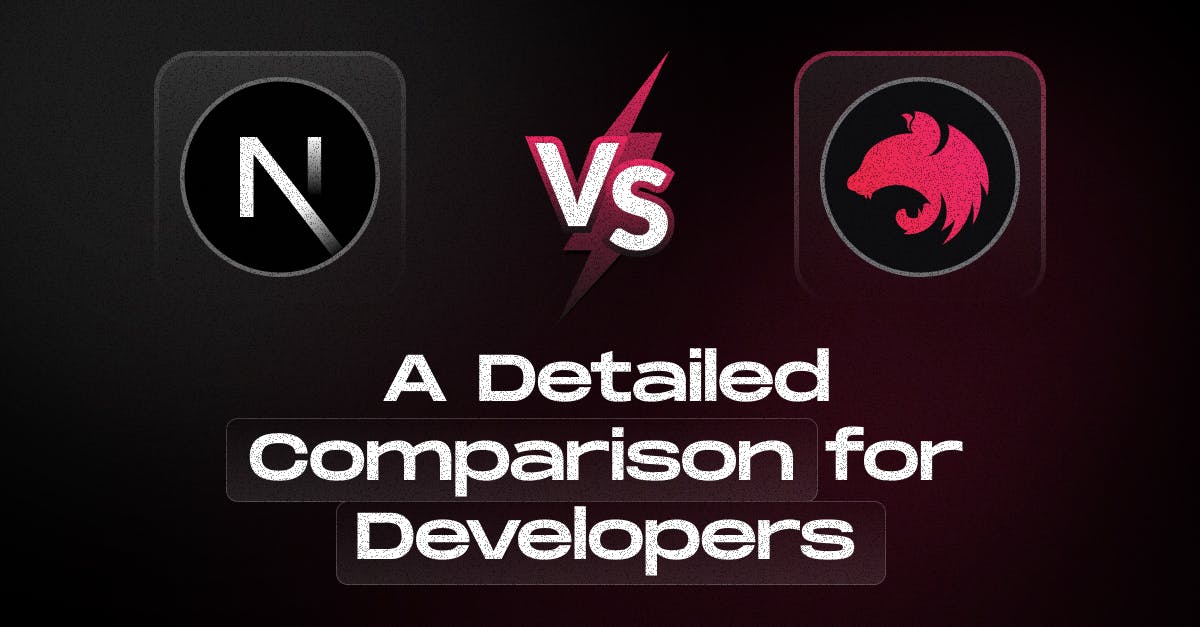March 4, 2025
Nest.js vs Next.js: Key Differences and Best Use Cases

Nusrat Sarmin

Confused between Nest.js and Next.js? If you're unsure which framework fits your goals, you’re in the right place to find answers. Both frameworks are widely used for building modern web applications. While their names sound similar, these frameworks serve very different purposes.
Nest.js is a backend framework for building scalable server-side applications, while Next.js is a frontend framework based on React, known for server-side rendering (SSR) and static site generation (SSG).
Choosing the right one depends on your project needs—whether you're building a robust API or a dynamic web interface. This comprehensive comparison of Nest.js vs Next.js will break down their features, use cases, and key differences. You'll walk away with a clear understanding to confidently choose between Nest.js and Next.js.
“The rising adoption of these frameworks reflects their growing importance—Nest.js usage increased by 45% in 2024, while Next.js powers over 1 million websites, including major brands like GitHub and Twitch, making them key players in modern web development.”
Overview of Nest.js Framework

Nest.js is a progressive backend framework for building scalable and maintainable server-side applications. It is built on top of Node.js platform and uses TypeScript by default, providing a structured and modular approach to application development. Inspired by Angular, Nest.js emphasizes dependency injection, decorators, and modular architecture.
Want to explore Nest.js deeper? Check out this comprehensive guide on What is Nest.js and why it stands out.
Here's What Makes Nest.js So Powerful
1. Structured Approach: Nest.js loves structure. With its modular architecture, it keeps your code neat, tidy, and easy to manage—even as your app grows.
2. Built to Scale: From small apps to massive enterprise-level systems, Nest.js scales like a champ. Its design supports microservices, GraphQL, and REST APIs effortlessly.
3. API Powerhouse: Nest.js simplifies REST and GraphQL API creation, providing robust features for building scalable and efficient APIs.
4. TypeScript's Trusted Ally: Built with TypeScript, Nest.js offers strong typing, better code quality, and enhanced developer productivity.
5. Dependency Injection: Nest.js uses built-in dependency injection for better code organization, improved testing, and easier maintenance.
6. Middleware and Guards: It offers flexible middleware and guards for handling authentication, logging, and request validation effortlessly.
Overview of Next.js Framework

Next.js, on the other hand, is a powerful framework built on top of the React library. Developed by Vercel, it focuses on server-side rendering, static site generation, and incremental static regeneration to optimize performance and SEO.
While primarily used as a frontend framework, it also supports backend logic, offering a seamless full-stack solution. Moreover, The future of Next.js appears promising, with ongoing development and enhancements aimed at solidifying its position as a leading framework.
Here's What Makes Next.js So Powerful
1. Speed Domain with Static Site Generation (SSG): Next.js supports static site generation out-of-the-box. This means lightning-fast page loads and improved user experience.
2. SEO Friendly by Design: With server-side rendering (SSR) and static generation, search engines love Next.js apps. It gives your pages the best chance to rank higher.
3. React's Best Friend: Next.js works seamlessly with React. If you know React, you’re already halfway there.
4. Built-in Features Galore: Automatic code splitting, image optimization, API routes—you name it, Next.js likely has it.
5. Hot Module Replacement for Rapid Development: Make a change, and see it live instantly. No need to refresh the entire app.
6. Scalability for the Future: From small projects to enterprise-grade apps, Next.js grows with you. And it's backed by Vercel, which means long-term support.
What Are the Key Differences? Nest.js vs Next.js
Both Nest.js and Next.js are popular frameworks in modern web development, but they serve different purposes. Let’s break down their core differences in architecture, use cases, and features.
1. Framework Type
- Nest.js: A backend framework for building scalable server-side applications using modern JavaScript and TypeScript patterns.
- Next.js: A frontend framework for building React-based web applications with advanced rendering techniques.
2. Core Technology
- Nest.js: Built on Node.js and TypeScript, inspired by Angular’s architecture. It uses Express.js (default) or Fastify as an underlying HTTP server.
- Next.js: Built on React and Node.js, developed by Vercel. It integrates seamlessly with modern edge computing for performance.
3. Architecture:
- NestJS follows a modular architecture and uses decorators and TypeScript to enable easy separation of concerns, making it suitable for large-scale applications.
- Next.js is structured around React components, with a built-in routing system based on file structure, making it easy to build pages, optimize, and deploy.
4. Performance
- Nest.js: Optimized for high-performance backend operations, supports asynchronous programming using RxJS.
- Next.js: Fast page loads through automatic code-splitting, caching, and edge computing with Vercel.
5. Scalability
- Nest.js: Designed for large-scale applications with its modular structure and microservice support.
- Next.js: Scales for high-traffic frontend applications through ISR (Incremental Static Regeneration) and SSG/SSR options.
6. Routing System
- Nest.js: Programmatic routing using decorators (e.g., @Get(), @Post()), similar to Express.js.
- Next.js: File-based routing where folders and files define routes automatically.
7. Rendering Approach
- Nest.js doesn’t care about rendering—it's all about backend logic.
- Next.js is all about rendering, offering static site generation (SSG), server-side rendering (SSR), and client-side rendering.
8. Learning Curve
- Nest.js: Moderate to steep – Requires familiarity with TypeScript, Object-Oriented Programming (OOP), and decorators. Developers from Angular or enterprise environments adapt faster.
- Next.js: Easy to moderate – If you know React, it's easy to start. Advanced features like SSR and ISR may need more understanding.
9. Community & Ecosystem
- Nest.js has a rapidly growing community, but it’s not as big as Next.js.
- Next.js is backed by Vercel and the massive React community—meaning tons of resources, plugins, and support.
10. Use Cases
- Nest.js: Ideal for creating RESTful APIs, GraphQL APIs, microservices, and enterprise-level applications.
- Next.js: Suitable for dynamic web applications, e-commerce sites, SEO-focused platforms, and static or hybrid websites.
So, Which One to Choose? Nestjs vs. Nextjs
Choosing between Next.js vs NestJS depends on your project's requirements since both frameworks serve different purposes:
Choose NestJS if:
- You’re building a backend system—NestJS is ideal for handling APIs and microservices.
- Scalability is a priority—Its modular architecture helps manage large-scale applications.
- TypeScript is essential—NestJS is built with TypeScript by default, ensuring type safety.
- You need advanced backend features—It supports WebSockets, GraphQL, and database integrations.
Ideal for:
- RESTful and GraphQL APIs
- Microservices architecture
- Enterprise-level applications
- Real-time applications
Choose Next.js if:
- You’re building a frontend application—especially if it’s a dynamic, high-performance website or web app.
- SEO is crucial—Next.js supports Server-Side Rendering (SSR) and Static Site Generation (SSG) to improve search engine visibility.
- You want a full-stack solution—Next.js has built-in API routes, allowing you to handle both client and server-side logic.
- Performance matters—Features like automatic code-splitting and image optimization make your app faster.
- Flexibility is key—You can choose SSR, SSG, or Client-Side Rendering (CSR) based on your needs.
Ideal for:
- E-commerce websites
- Marketing sites
- Progressive Web Apps (PWAs)
- Content-heavy platforms
Final Resolution
Each framework—Nest.js and Next.js—excels in its domain, making them valuable in the right context. The decision between Nest.js vs Next.js ultimately comes down to the specific requirements of your project. By understanding their strengths and how they complement each other, you can build a more efficient and scalable application.
Need a website that’s fast, flexible, and built to perform? StaticMania delivers cutting-edge, adaptable websites that power your online success. Let’s bring your vision to life!
Nest.js vs. Next.js: FAQ
No, Nest.js and Next.js are different frameworks for distinct purposes. Nest.js is a backend framework for building server-side applications, while Next.js is a frontend framework for creating React-based web applications with server-side rendering (SSR) capabilities.
Nest.js is a backend framework. It is built on Node.js and designed for building scalable and maintainable server-side applications.
Next.js is primarily a frontend framework, but it also supports full-stack development through API routes, allowing you to handle backend logic within the same project.
- Nest.js: Best if you need a dedicated backend for complex APIs, microservices, or enterprise applications.
- Next.js: Ideal if you want a unified approach to building both the frontend and backend for web applications using React.
Yes, you can combine Nest.js and Next.js. Use Nest.js for the backend API and Next.js for the frontend, allowing a modular and scalable architecture.
- Nest.js: Easier if you're familiar with TypeScript and object-oriented programming.
- Next.js: Easier if you already know React and want to extend it with server-side and static rendering.
It depends on your project needs:
- Nest.js: Ideal for building robust, maintainable backend services, especially if you need complex APIs or microservices.
- Next.js: Perfect for building React applications with server-side rendering, static site generation, and full-stack capabilities in one unified framework.
Use Nest.js when building:
- RESTful APIs and GraphQL services
- Microservices and enterprise applications
- Scalable, maintainable backend systems
Use Next.js for:
- SEO-friendly web applications
- Static site generation (SSG) and server-side rendering (SSR)
- Full-stack React applications

